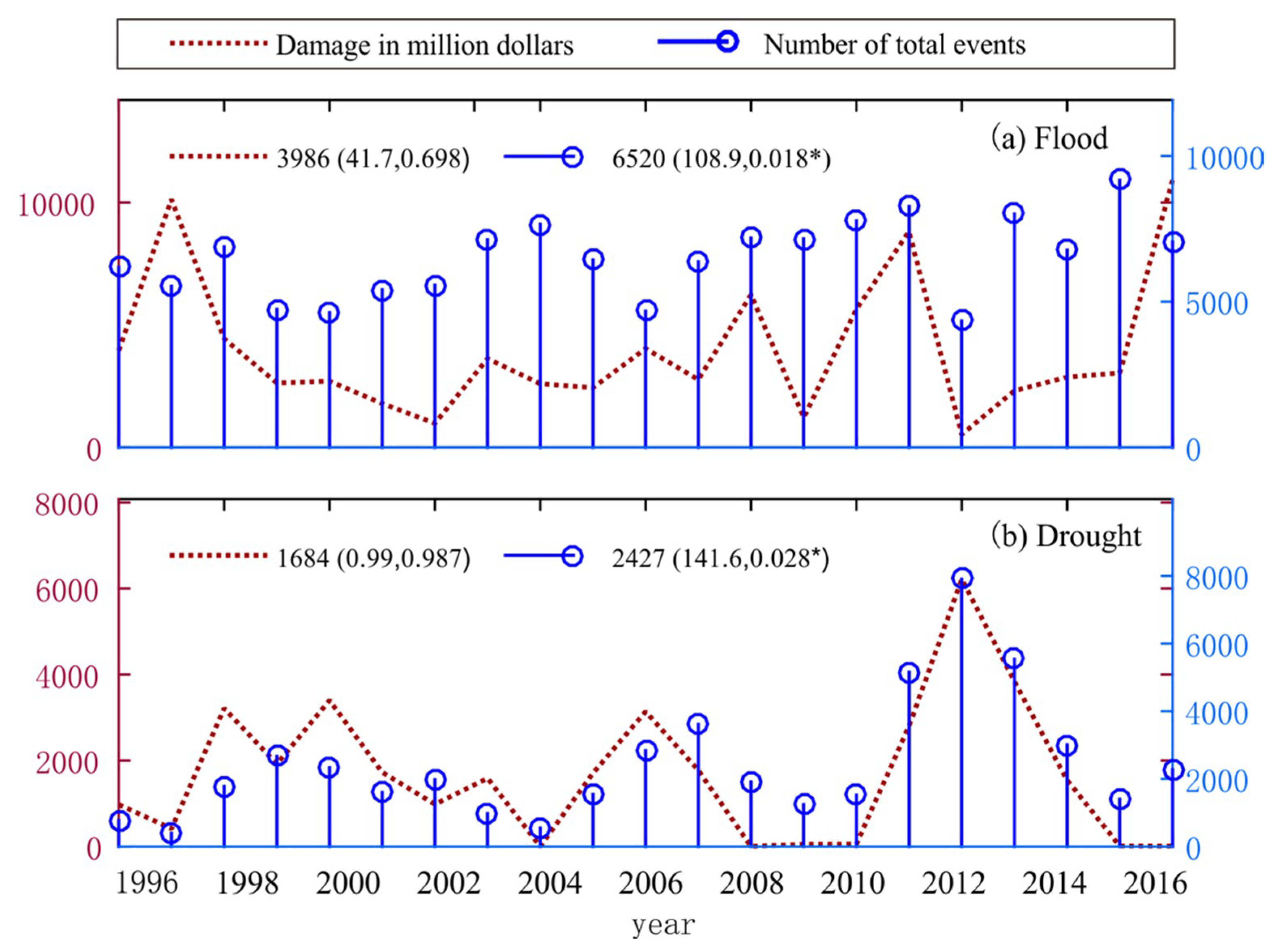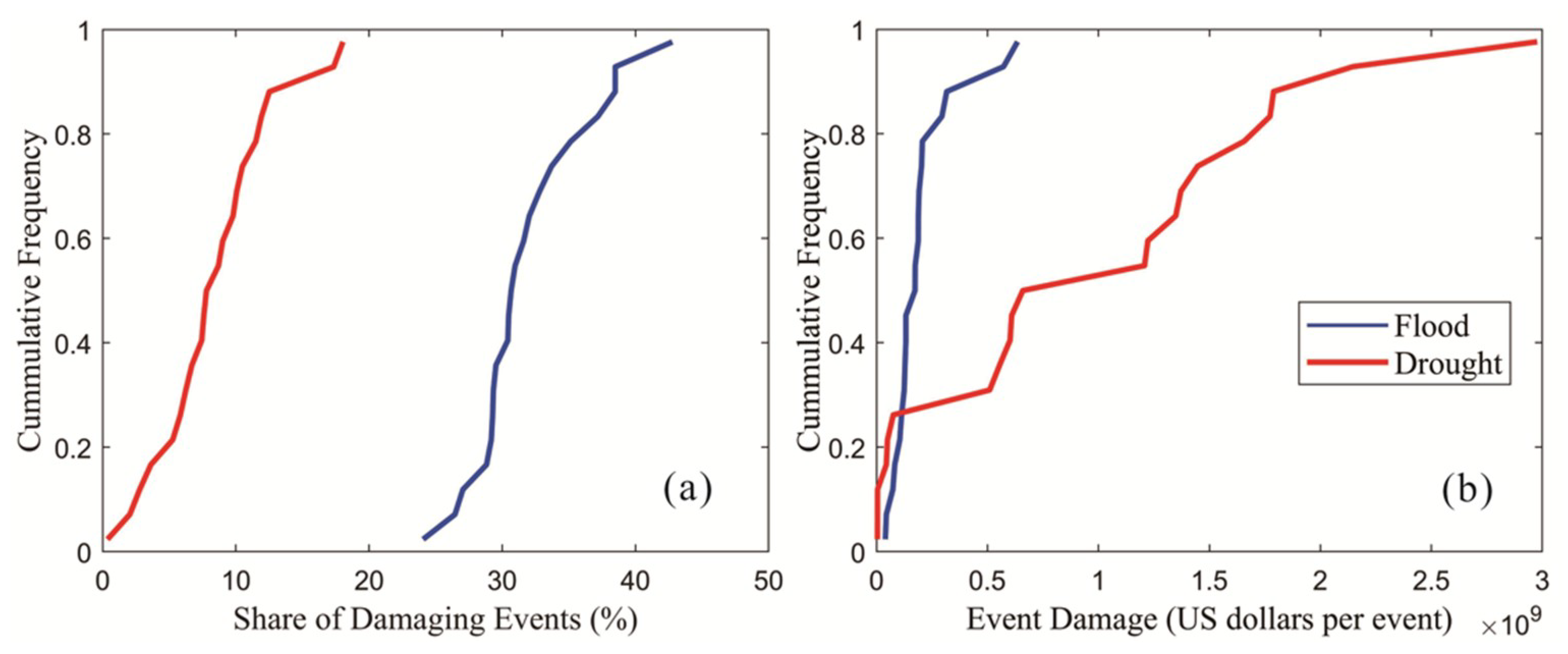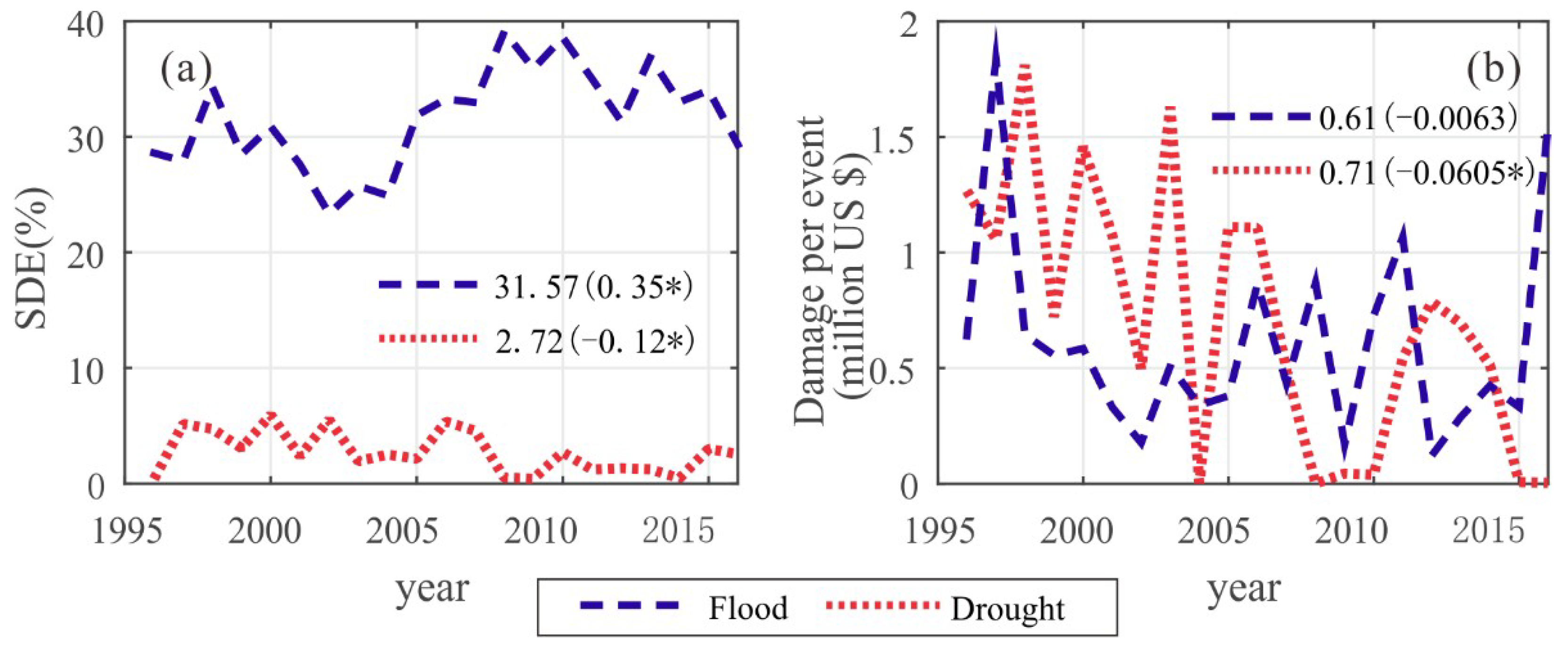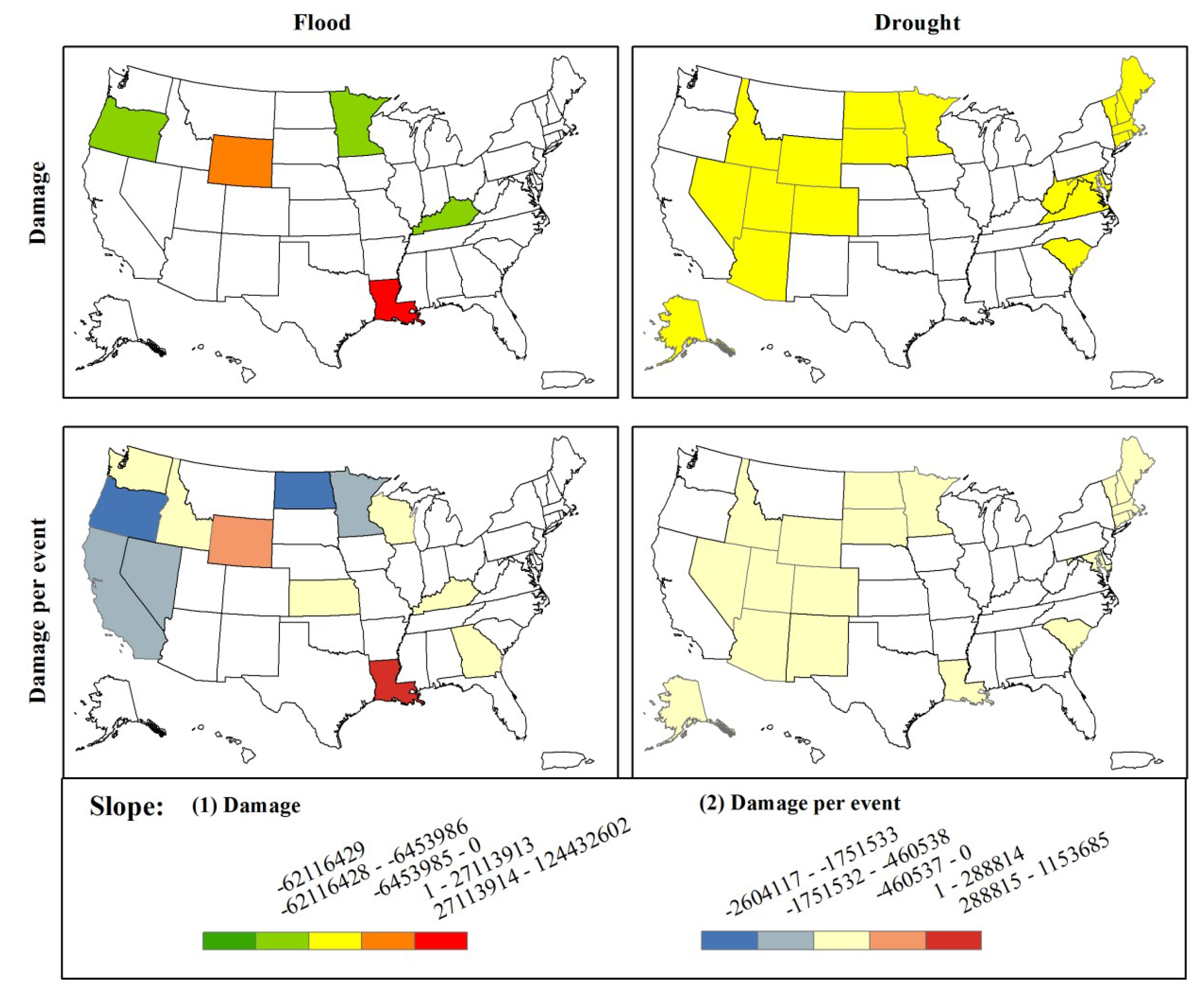Recent Changes in the Occurrences and Damages of Floods and Droughts in the United States
Abstract
1. Introduction
2. Materials and Methods
3. Results
4. Conclusions
Author Contributions
Funding
Acknowledgments
Conflicts of Interest
References
- Hirabayashi, Y.; Mahendran, R.; Koirala, S.; Konoshima, L.; Yamazaki, D.; Watanabe, S.; Kim, H.; Kanae, S. Global flood risk under climate change. Nat. Clim. Chang. 2013, 3, 816. [Google Scholar] [CrossRef]
- Ntelekos, A.A.; Oppenheimer, M.; Smith, J.A.; Miller, A.J. Urbanization, climate change and flood policy in the united states. Clim. Chang. 2010, 103, 597–616. [Google Scholar] [CrossRef]
- Lamond, J.; Wilkinson, S.; Rose, C. Conceptualising the benefits of green roof technology for commercial real estate owners and occupiers. In Proceedings of the 20th Annual PRRES Conference, Christchurch, New Zealand, 19–22 January 2014; Pacific Rim Real Estate Society: Christchurch, New Zealand, 2014; pp. 1–10. [Google Scholar]
- Kundzewicz, Z.W.; Kaczmarek, Z. Coping with hydrological extremes. Water Int. 2000, 25, 66–75. [Google Scholar] [CrossRef]
- Billion-Dollar Weather and Climate Disasters: Overview. 2018. Available online: https://www.ncdc.noaa.gov/billions/ (accessed on 12 March 2018).
- Rabuñal, J.R.; Puertas, J.; Suárez, J.; Rivero, D. Determination of the unit hydrograph of a typical urban basin using genetic programming and artificial neural networks. Hydrol. Process. 2007, 21, 476–485. [Google Scholar] [CrossRef]
- Stewart, I.T.; Ficklin, D.L.; Carrillo, C.A.; McIntosh, R. 21st century increases in the likelihood of extreme hydrologic conditions for the mountainous basins of the southwestern united states. J. Hydrol. 2015, 529, 340–353. [Google Scholar] [CrossRef]
- Takeuchi, K. Increasing vulnerability to extreme floods and societal needs of hydrological forecasting. Hydrol. Sci. J. 2001, 46, 869–881. [Google Scholar] [CrossRef]
- Huang, S.; Leng, G.; Huang, Q.; Xie, Y.; Liu, S.; Meng, E.; Li, P. The asymmetric impact of global warming on us drought types and distributions in a large ensemble of 97 hydro-climatic simulations. Sci. Rep. 2017, 7, 5891. [Google Scholar] [CrossRef] [PubMed]
- Leng, G.; Tang, Q.; Rayburg, S. Climate change impacts on meteorological, agricultural and hydrological droughts in China. Glob. Planet. Chang. 2015, 126, 23–34. [Google Scholar] [CrossRef]
- Trenberth, K.E.; Dai, A.; van der Schrier, G.; Jones, P.D.; Barichivich, J.; Briffa, K.R.; Sheffield, J. Global warming and changes in drought. Nat. Clim. Chang. 2014, 4, 17–22. [Google Scholar] [CrossRef]
- Peterson, T.C.; Heim, R.R.; Hirsch, R.; Kaiser, D.P.; Brooks, H.; Diffenbaugh, N.S.; Dole, R.M.; Giovannettone, J.P.; Guirguis, K.; Karl, T.R.; et al. Monitoring and understanding changes in heat waves, cold waves, floods, and droughts in the united states: State of knowledge. Bull. Am. Meteorol. Soc. 2013, 94, 821–834. [Google Scholar] [CrossRef]
- Patz, J.A.; Campbell-Lendrum, D.; Holloway, T.; Foley, J.A. Impact of regional climate change on human health. Nature 2005, 438, 310. [Google Scholar] [CrossRef] [PubMed]
- Parr, D.; Wang, G.L.; Ahmed, K.F. Hydrological changes in the us northeast using the connecticut river basin as a case study: Part 2. Projections of the future. Glob. Planet. Change 2015, 133, 167–175. [Google Scholar] [CrossRef]
- U.S. Climate Extremes Index (CEI): Introduction. 2018. Available online: http://www.ncdc.noaa.gov/extremes/cei/ (accessed on 5 February 2018).
- Retchless, D.; Frey, N.; Wang, C.M.; Hung, L.S.; Yarnal, B. Climate extremes in the united states: Recent research by physical geographers. Phys. Geogr. 2014, 35, 3–21. [Google Scholar] [CrossRef]
- Villarini, G.; Smith, J.A.; Baeck, M.L.; Krajewski, W.F. Examining flood frequency distributions in the midwest US. J. Am. Water Resour. Assoc. 2011, 47, 447–463. [Google Scholar] [CrossRef]
- Kubal, C.; Haase, D.; Meyer, V.; Scheuer, S. Integrated urban flood risk assessment - adapting a multicriteria approach to a city. Nat. Hazards Earth Syst. Sci. 2009, 9, 1881–1895. [Google Scholar] [CrossRef]
- Knutti, R.; Furrer, R.; Tebaldi, C.; Cermak, J.; Meehl, G.A. Challenges in combining projections from multiple climate models. J. Clim. 2010, 23, 2739–2758. [Google Scholar] [CrossRef]
- Changnon, S.A. Assessment of flood losses in the United States. J. Contemp. Water Res. Educ. 2008, 138, 38–44. [Google Scholar] [CrossRef]
- Kundzewicz, Z.W.; Kanae, S.; Seneviratne, S.I.; Handmer, J.; Nicholls, N.; Peduzzi, P.; Mechler, R.; Bouwer, L.M.; Arnell, N.; Mach, K.; et al. Flood risk and climate change: Global and regional perspectives. Hydrol. Sci. J. 2014, 59, 1–28. [Google Scholar] [CrossRef]
- Ashley, S.T.; Ashley, W.S. Flood fatalities in the United States. J. Appl. Meteorol. Climatol. 2008, 47, 805–818. [Google Scholar] [CrossRef]
- Borden, K.A.; Cutter, S.L. Spatial patterns of natural hazards mortality in the United States. Int. J. Health Geogr. 2008, 7, 64. [Google Scholar] [CrossRef] [PubMed]
- Brown, R.R.; Farrelly, M.A. Delivering sustainable urban water management: A review of the hurdles we face. Water Sci. Technol. 2009, 59, 839–846. [Google Scholar] [CrossRef] [PubMed]
- Wilhite, D.A.; Svoboda, M.D.; Hayes, M.J. Understanding the complex impacts of drought: A key to enhancing drought mitigation and preparedness. Water Resour. Manag. 2007, 21, 763–774. [Google Scholar] [CrossRef]
- Sheffield, J.; Goteti, G.; Wen, F.; Wood, E.F. A simulated soil moisture based drought analysis for the United States. J. Geophys. Res. Atmos. 2004, 109. [Google Scholar] [CrossRef]
- Kron, W. Flood risk = hazard • values • vulnerability. Water Int. 2005, 30, 58–68. [Google Scholar] [CrossRef]
- Hohhot Water Bureau (HWB). Planning and Risk Assessment of Urban Drainage (Stormwater System) in Hohhot City; Technical Report; Hohhot Water Bureau: Hohhot, China, 2015.
- Wang, A.K.; Park, S.Y.; Huang, S.; Schmidt, A.R. Hydrologic response of sustainable urban drainage to different climate scenarios. In World Environmental and Water Resources Congress 2015: Floods, Droughts, and Ecosystems, Proceedings of the 2015 World Environmental and Water Resources Congress, Austin, TX, USA, 17–21 May 2015; American Society of Civil Engineers (ASCE): Reston, VA, USA, 2015; pp. 312–321. [Google Scholar]
- Yasari, E.; Pishvaie, M.R.; Khorasheh, F.; Salahshoor, K.; Kharrat, R. Application of multi-criterion robust optimization in water-flooding of oil reservoir. J. Pet. Sci. Eng. 2013, 109, 1–11. [Google Scholar] [CrossRef]
- Mechler, R.; Bouwer, L.M.; Linnerooth-Bayer, J.; Hochrainer-Stigler, S.; Aerts, J.C.J.H.; Surminski, S.; Williges, K. Managing unnatural disaster risk from climate extremes. Nat. Clim. Chang. 2014, 4, 235. [Google Scholar] [CrossRef]
- Ward, P.J.; Jongman, B.; Weiland, F.S.; Bouwman, A.; van Beek, R.; Bierkens, M.F.P.; Ligtvoet, W.; Winsemius, H.C. Assessing flood risk at the global scale: Model setup, results, and sensitivity. Environ. Res. Lett. 2013, 8, 044019. [Google Scholar] [CrossRef]
- Smedley, P.L.; Zhang, M.; Zhang, G.; Luo, Z. Mobilisation of arsenic and other trace elements in fluviolacustrine aquifers of the Huhhot basin, Inner Mongolia. Appl. Geochem. 2003, 18, 1453–1477. [Google Scholar] [CrossRef]
- Zhou, Q.; Leng, G.; Feng, L. Predictability of state-level flood damage in the conterminous united states: The role of hazard, exposure and vulnerability. Sci. Rep. 2017, 7, 5354. [Google Scholar] [CrossRef] [PubMed]
- Nicholls, N. Comments on “Have disaster losses increased due to anthropogenic climate change?”. Bull. Am. Meteorol. Soc. 2011, 92, 791. [Google Scholar] [CrossRef]
- Neumayer, E.; Barthel, F. Normalizing economic loss from natural disasters: A global analysis. Glob. Environ. Chang. 2011, 21, 13–24. [Google Scholar] [CrossRef]
- Mukherjee, A.; Bhattacharya, P.; Shi, F.; Fryar, A.E.; Mukherjee, A.B.; Xie, Z.M.; Jacks, G.; Bundschuh, J. Chemical evolution in the high arsenic groundwater of the Huhhot basin (inner Mongolia, Pr china) and its difference from the western Bengal basin (India). Appl. Geochem. 2009, 24, 1835–1851. [Google Scholar] [CrossRef]
- Peduzzi, P.; Chatenoux, B.; Dao, H.; De Bono, A.; Herold, C.; Kossin, J.; Mouton, F.; Nordbeck, O. Global trends in tropical cyclone risk. Nat. Clim. Chang. 2012, 2, 289. [Google Scholar] [CrossRef]
- Wu, J.; Han, G.; Zhou, H.; Li, N. Economic development and declining vulnerability to climate-related disasters in China. Environ. Res. Lett. 2018, 13, 034013. [Google Scholar] [CrossRef]
- National Weather Service Instruction 10–1605, Storm Data Preparation. 2016. Available online: https://www.ncdc.noaa.gov/stormevents/pd01016005curr.pdf (accessed on 8 March 2018).
- Sisco, M.R.; Bosetti, V.; Weber, E.U. When do extreme weather events generate attention to climate change? Clim. Chang. 2017, 143, 227–241. [Google Scholar] [CrossRef]
- Chen, J.; Hill, A.A.; Urbano, L.D. A gis-based model for urban flood inundation. J. Hydrol. 2009, 373, 184–192. [Google Scholar] [CrossRef]
- Dundon, L.; Nelson, K.; Camp, J.; Abkowitz, M.; Jones, A. Using climate and weather data to support regional vulnerability screening assessments of transportation infrastructure. Risks 2016, 4, 28. [Google Scholar] [CrossRef]
- Wobus, C.; Lawson, M.; Jones, R.; Smith, J.; Martinich, J. Estimating monetary damages from flooding in the united states under a changing climate. J. Flood Risk Manag. 2014, 7, 217–229. [Google Scholar] [CrossRef]
- Edwards, R.; LaDue, J.G.; Ferree, J.T.; Scharfenberg, K.; Maier, C.; Coulbourne, W.L. Tornado intensity estimation past, present and future. Bull. Am. Meteorol. Soc. 2013, 94, 641–653. [Google Scholar] [CrossRef]
- Belanger, J.I.; Curry, J.A.; Hoyos, C.D. Variability in tornado frequency associated with U.S. Landfalling tropical cyclones. Geophys. Res. Lett. 2009, 36. [Google Scholar] [CrossRef]
- Ashley, W.S.; Gilson, C.W. A reassessment of U.S. Lightning mortality. Bull. Am. Meteorol. Soc. 2009, 90, 1501–1518. [Google Scholar] [CrossRef]
- Gall, M.; Borden, K.A.; Cutter, S.L. When do losses count? Bull. Am. Meteorol. Soc. 2009, 90, 799–809. [Google Scholar] [CrossRef]
- Mishra, A.K.; Singh, V.P. A review of drought concepts. J. Hydrol. 2010, 391, 202–216. [Google Scholar] [CrossRef]
- Cook, B.I.; Ault, T.R.; Smerdon, J.E. Unprecedented 21st century drought risk in the American southwest and central plains. Sci. Adv. 2015, 1. [Google Scholar] [CrossRef] [PubMed]
- Barbero, R.; Fowler, H.J.; Lenderink, G.; Blenkinsop, S. Is the intensification of precipitation extremes with global warming better detected at hourly than daily resolutions? Geophys. Res. Lett. 2017, 44, 974–983. [Google Scholar] [CrossRef]
- Siegrist, M.; Gutscher, H. Natural hazards and motivation for mitigation behavior: People cannot predict the affect evoked by a severe flood. Risk Anal. 2008, 28, 771–778. [Google Scholar] [CrossRef] [PubMed]
- Kreibich, H.; Thieken, A.H.; Petrow, T.; Muller, M.; Merz, B. Flood loss reduction of private households due to building precautionary measures—Lessons learned from the Elbe flood in august 2002. Nat. Hazards Earth Syst. Sci. 2005, 5, 117–126. [Google Scholar] [CrossRef]
- Grothmann, T.; Reusswig, F. People at risk of flooding: Why some residents take precautionary action while others do not. Nat. Hazards 2006, 38, 101–120. [Google Scholar] [CrossRef]
- Stakhiv, E.Z.; Werick, W.; Brumbaugh, R.W. Evolution of drought management policies and practices in the United States. Water Policy 2016, 18, 122–152. [Google Scholar] [CrossRef]
- Downton, M.W.; Miller, J.Z.B.; Pielke, R.A. Reanalysis of U.S. National weather service flood loss database. Nat. Hazards Rev. 2005, 6, 13. [Google Scholar] [CrossRef]





| Group | Impact Metrics | Descriptions |
|---|---|---|
| 1 | Total occurrences | Annual number of recorded events (TO) |
| Number of events with impacts | Number of events with damages (NED) | |
| Ratio of events with impacts | Share of damaging events (SDE = NED/TO) | |
| 2 | Total impacts | Annual economic damages (D) |
| Impacts per event | Damage per event (DPE = D/TO) |
© 2018 by the authors. Licensee MDPI, Basel, Switzerland. This article is an open access article distributed under the terms and conditions of the Creative Commons Attribution (CC BY) license (http://creativecommons.org/licenses/by/4.0/).
Share and Cite
Zhou, Q.; Leng, G.; Peng, J. Recent Changes in the Occurrences and Damages of Floods and Droughts in the United States. Water 2018, 10, 1109. https://doi.org/10.3390/w10091109
Zhou Q, Leng G, Peng J. Recent Changes in the Occurrences and Damages of Floods and Droughts in the United States. Water. 2018; 10(9):1109. https://doi.org/10.3390/w10091109
Chicago/Turabian StyleZhou, Qianqian, Guoyong Leng, and Jian Peng. 2018. "Recent Changes in the Occurrences and Damages of Floods and Droughts in the United States" Water 10, no. 9: 1109. https://doi.org/10.3390/w10091109
APA StyleZhou, Q., Leng, G., & Peng, J. (2018). Recent Changes in the Occurrences and Damages of Floods and Droughts in the United States. Water, 10(9), 1109. https://doi.org/10.3390/w10091109







